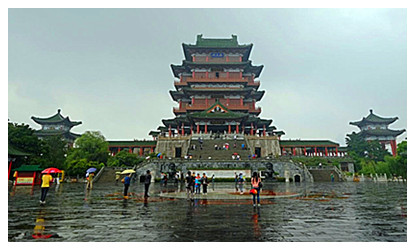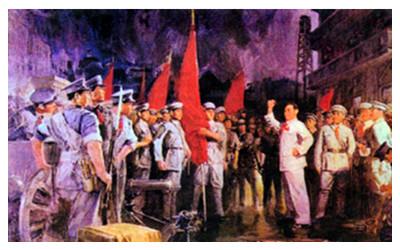Skype: neodalle-travel
Tel: +86 135 7447 2266
E-mail: sales@visitaroundchina.com
During the Spring and Autumn Period (770-476 BC), Jiangxi encompassed the territories of the States of Wu, Yue and Chu. Then, in the Warring States Period (475-221 BC), Jiangxi was under the jurisdiction of the State of Yue.
After Emperor Qin Shihuang unified China in 221 BC, Jiangxi became part of the Jiujiang Prefecture.
At the beginning of the Western Han Dynasty (202 BC), Jiangxi was renamed "Yuzhang Prefecture", which was changed into Hongzhou Area Command during the Sui Dynasty (581-618 AD).
 In the 21st year of the Kaiyuan reign of the Tang Dynasty (733 AD), Emperor Xuanzong divided the country into 15 "dao". Hongzhou was then the capital of the Jiangnan Xidao, short as Jiangxi. Eight prefectures, Hongzhou, Raozhou, Qianzhou, Jizhou, Jiangzhou, Yuanzhou, Fuzhou, and Xinzhou were placed under its jurisdiction. They formed the picture as Wang Bo described "Opulent prefectures spread out like fog in its immensity." in his "Pavilion of Prince Teng".
In the 21st year of the Kaiyuan reign of the Tang Dynasty (733 AD), Emperor Xuanzong divided the country into 15 "dao". Hongzhou was then the capital of the Jiangnan Xidao, short as Jiangxi. Eight prefectures, Hongzhou, Raozhou, Qianzhou, Jizhou, Jiangzhou, Yuanzhou, Fuzhou, and Xinzhou were placed under its jurisdiction. They formed the picture as Wang Bo described "Opulent prefectures spread out like fog in its immensity." in his "Pavilion of Prince Teng".
The Yuan Dynasty (1279-1368) set up provinces, hence the name Jiangxi province.
The Ming Dynasty changed "dao" into "buzhenshisi", equivalent to a province.
The Qing Dynasty (1644-1911) set up Jiangxi province again, which remained the name since then.
Since ancient times, Jiangxi has been culturally advanced. Many talented natives have been taken to the national stage. These include Tao Yuanming (365-427)of the Jin Dynasty; three of the eight most famous writers of the Tang and Song Dynasty -Ouyang Xiu(1007-1072), Zeng Gong and Wang Anshi (1021-1086); poet and calligrapher Huang Tingjian, poet Yang Wanli, ci poet Jiang Kui, philosophers and educators Zhu Xi (1130-1200)and Lu Jiuyuan, and the national hero WenTianxiang(1236-1282) of the Song Dynasty; dramatist Tang Xianzu (1550-1616)and scientist Song Yingxing of the Ming Dynasty; painter Zhu Da and railway engineer Zhan Tianyou of the Qing Dynasty, proletariat Wu Youxun and numerous general of the People' Liberation Army during the modern era. They have contributed precious spiritual wealth to Jiangxi.
Jiangxi in 1020s-1930s
Jiangxi is a cradle of the Chinese revolution. The rural revolutionary base established by Mao Zedong in Jinggang Mountain is known as "The Red City."
Jaingxi in 1927
On August 1, 1927, the Communist Party of China (CPC) launched an armed uprising in Nanchang, the capital of Jiangxi Province. The Nanchang Uprising led by Zhou Enlai, He Long, Ye Ting, Zhu De and Liu Bocheng gave birth to the armed forces of the CPC and marked the beginning of CPC's independent leadership over armed struggles.
On August 7, 1927, the CPC Central Committee convened a meeting on August 7 in Wuhan. At the meeting, the general principle of carrying out Agrarian Revolution and armed resistance against Kuomintang reactionaries was made.
On September 9, 1927, under the leadership of Mao Zedong, the peasants living in the Hunan-Jiangxi border area launched the Autumn Harvest Uprising.
On September 29, 1927, Mao Zedong carried out experiment to “establish branches of the CPC at the level of companies” in the Autumn Harvest Uprising troops during the Sanwan Reorganization, which symbolized the beginning of an army of the Chinese people under the leadership of the CPC.
In October 1927, the Autumn Harvest Uprising troops led by Mao Zedong arrived in the Jinggang Mountain area and created the first countryside revolutionary base area there.
On December 11, 1927, under the leadership of Zhang Tailei, Ye Ting, Yun Daiying and Ye Jianying, the armed workers and some troops commanded by the CPC launched an uprising in Guangzhou to fight against the Kuomintang rightists' slaughter of members of the CPC and its supporters.
Jiangxi in 1928
 In April 1928, led by Zhu De and Chen Yi, the workers' and peasants' revolutionary army composed of the remained troops of the Nanchang Uprising and the armed peasants from southern Hunan Province joined forces in the Jinggang Mountain with the workers' and peasants' revolutionary army established by Mao Zedong after the Autumn Harvest Uprising in the Hunan-Jiangxi border area.
In April 1928, led by Zhu De and Chen Yi, the workers' and peasants' revolutionary army composed of the remained troops of the Nanchang Uprising and the armed peasants from southern Hunan Province joined forces in the Jinggang Mountain with the workers' and peasants' revolutionary army established by Mao Zedong after the Autumn Harvest Uprising in the Hunan-Jiangxi border area.
In October 1928, the Central Military Department of the Communist Party of China (CPC) was set up.
On December 28 and 29, 1929, the 9th Party Congress of the Fourth Army of the Chinese Workers' and Peasants' Red Army was held in Gutian Village, Shanghang County of Fujian Province, which was later called the Gutian Meeting. At the meeting, the fundamental principles of building the Chinese Workers' and Peasants' Red Army were established and the questions on how to build an army mainly composed of peasants into a new-type army of Chinese people under the absolute leadership of the CPC were answered. The Gutian Meeting is a milestone in the history of the building of the Communist Party of China and the army.
Jiangxi In 1930
In March 1930, the Central Military Department of the CPC was renamed the Central Military Commission of the CPC.
On August 23, 1930, the First Front Army of the Chinese Workers' and Peasants' Red Army was formed in Liuyang County, Hunan Province.
Jiangxi In 1931
On November 7, 1931, the Fourth Front Army of the Chinese Workers' and Peasants' Red Army came into being in Huang'an County, Hubei Province.
On November 25, 1931, the Central Revolutionary Military Commission of the Soviet Republic of China was established in Ruijin, Jiangxi Province.
Jiangxi In 1932
In December 1932, the Fourth Front Army of the Chinese Workers' and Peasants' Red Army marched to the northern Sichuan Province and started to create the Sichuan-Shaanxi Border Base Area.
Jiangxi In 1933
On May 8, 1933, the general headquarters of the Chinese Workers' and Peasants' Red Army was set up.
On July 11, 1933, the Provisional Central Government of the Chinese Soviet Republic of China made a decision to set the August 1,the date of the Nanchang Uprising, as the anniversary of the founding of the Chinese Workers' and Peasants' Red Army. Since then, the August 1 each year has become the Army Day of the Chinese People's Liberation Army.
Jiangxi In 1934
In October 1934, the First Front Army of the Chinese Workers' and Peasants' Red Army withdrew from the Central Base Area in Jiangxi Province and embarked on the Long March.
On November 16, 1934, the 25th Army of the Chinese Workers' and Peasants' Red Army abandoned the Hubei-Henan-Anhui Border Base Area and started its Long March.
Jiangxi In 1935
From January 15 to 17, 1935, the Zunyi Meeting, an enlarged meeting of the Political Bureau of the CPC Central Committee, was held at Zunyi, Guizhou Province during the Long March. The Zunyi Meeting organizationally ended the domination of Wang Ming's "Left" adventurism in the CPC Central Committee, established the correct leadership of the new Central Committee represented by Mao Zedong,thus saving the Red Army and the CPC from destruction at a most critical juncture.
In March 1935, the Fourth Front Army of the Red Army launched the Jialin River Campaign and then evacuated the Sichuan-Shannxi Border Base Area to start the Long March.
On September 16, 1935, the 25th Army of the Red Army ended its Long March by joining force with the Red Army troops in northwest China at the Yongping Town of Yanchuna County of northern Shaanxi Province.
On October 19, 1935, the main force of the First Front Army of the Red Army led by the CPC Central Committee arrived at the Wuqi Town in northern Shaanxi Province, which was the terminal of the Long March.
From December 17 to 25, 1935, the Political Bureau of the CPC Central Committee held an enlarged meeting to make the policy and strategic guide line of the Anti-Japanese National United Front.
Jiangxi In 1936
On February 20, 1936, the anti-Japanese forces in different places in northeast China were reorganized into the Northeast Anti-Japanese United Forces.
On July 5, 1936, the 2nd and 6th Corps and the 32nd Army of the Red Army merged to form the Red Army's Second Front Army in the Long March.
In July 1936, the 1st Route Army of the Northeast Anti-Japanese United Forces was established.
In October 1936, the First , Second and the Fourth Front Armies of the Red Army jointed forces in the Shaanxi-Gansu-Ningxia Border Area.
Nowadays, covering an area of 167,000 square kilometers, with a population of 45 million, Jiangxi has a total of 11 prefecture-level cities, including Nanchang City, Jingdezhen City, Pingxiang City, Jiujiang City, Xinyu City, Yingtan City, Ganzhou City, Ji'an City, Yichun City, Fuzhou City, and Shangrao City.
 Ask Questions ?
Ask Questions ?